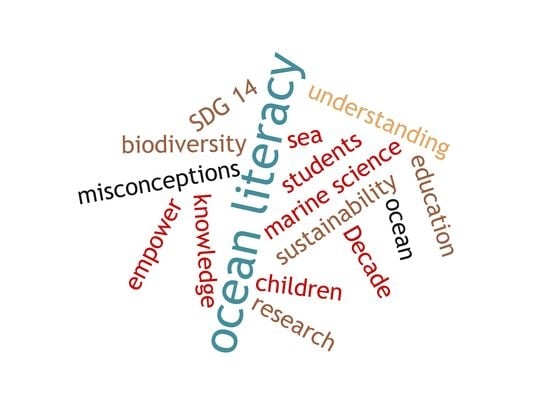How to Increase Ocean Literacy for Future Ocean Sustainability? The Influence of Non-Formal Marine Science Education
Abstract
1. Introduction
- The Earth has one big ocean with many features;
- The ocean and life in the ocean shape the features of Earth;
- The ocean is a major influence on weather and climate;
- The ocean made Earth habitable;
- The ocean supports a great diversity of life and ecosystems;
- The ocean and humans are inextricably interconnected; and
- The ocean is largely unexplored.
2. Materials and Methods
3. Results
3.1. Pre-Test
3.2. Post-Test
4. Discussion
5. Conclusions
Author Contributions
Funding
Acknowledgments
Conflicts of Interest
References
- United Nations. The First Global Integrated Marine Assessment—World Ocean Global Assessment 1; UN: New York, NY, USA, 2016. [Google Scholar]
- Visbeck, M. Ocean science research is key for a sustainable future. Nature Commun. 2018, 9, 690. [Google Scholar] [CrossRef]
- Cava, F.; Schoedinger, S.; Strang, C.; Tuddenham, P. Science Content and Standards for Ocean Literacy: A Report on Ocean Literacy. 2005. Available online: http://oceanliteracy.ca/wp-content/uploads/Science-Content-and-Standards-of-Ocean-Literacy.pdf (accessed on 10 June 2020).
- Charlier, P.S.; Charlier, R.H. A case for oceanography at the inland school. Sci. Educ. 1971, 55, 15–20. [Google Scholar] [CrossRef]
- Goodwin, H.L.; Schaadt, J.G. A Statement on the Need for Marine and Aquatic Education. To Inform Americans about the World of Water; Delaware Sea Grant College Program, University of Delaware: Newark, DE, USA, 1978. [Google Scholar]
- McFadden, D.L. Teaching in the tidepools. West coast children study the marine sciences at first hand. Oceans 1973, 6, 44–49. [Google Scholar]
- Dresser, H.H.; Butzow, J.W. The effects of selected variables on the implementation of a marine education infusion curriculum. School Sci. Math. 1981, 81, 480–486. [Google Scholar] [CrossRef]
- Fortner, R.W.; Mayer, V.J. Marine and aquatic education—A challenge for science educators. Sci. Educ. 1989, 73, 135–154. [Google Scholar] [CrossRef]
- Schoedinger, S.; Tran, L.U.; Whitley, L. From the principles to the scope and sequence: A brief history of the ocean literacy campaign. NMEA Spec. Rep. 2010, 3, 3–7. [Google Scholar]
- Santoro, F.; Santin, S.; Scowcroft, G.; Fauville, G.; Tuddenham, P. Ocean Literacy for All—A Toolkit; IOC/UNESCO and UNESCO Venice Office (IOC Manuals and Guides): Paris, France, 2017. [Google Scholar]
- Fortner, R.W.; Manzo, L. Great Lakes literacy principles. Eos Trans. Am. Geophys. Union 2011, 92, 109. [Google Scholar] [CrossRef]
- Mokos, M.; Cheimonopoulou, M.T.; Koulouri, P.; Previati, M.; Realdon, G.; Santoro, F.; Mogias, A.; Bounonari, T.; Gazo, M.; Satta, A.; et al. Mediterranean Sea Literacy: When Ocean Literacy becomes region-specific. Mediterr. Mar. Sci. 2020, 21, 592–598. [Google Scholar]
- UN. United Nations Decade of Ocean Science for Sustainable Development 2021–2030 Implementation Plan, Version 2.0 July 2020; UNESCO: Paris, France, 2020. [Google Scholar]
- Ryabinin, V.; Barbière, J.; Haugan, P.; Kullenberg, G.; Smith, N.; McLean, C.; Troisi, A.; Fischer, A.; Aricò, S.; Aarup, T.; et al. The UN Decade of Ocean Science for Sustainable Development. Front. Mar. Sci. 2019, 6, 470. [Google Scholar] [CrossRef]
- Brody, M.; Koch, H. An assessment of 4th-, 8th-, and 11th-grade students’ knowledge related to marine sciences and natural resource issues. J. Environ. Educ. 1990, 21, 16–26. [Google Scholar] [CrossRef]
- Brody, M.J. Student understanding of water and water resources: A review of the literature. In Proceedings of the Annual Meeting of the American Educational Research Association, Atlanta, GA, USA, 12–16 April 1993. [Google Scholar]
- Rodriguez-Martinez, R.; Ortiz, L.M. Coral reef education in schools of Quintana Roo, Mexico. Ocean Coast. Manag. 1999, 42, 1061–1068. [Google Scholar] [CrossRef]
- Ballantyne, R. Young students’ conceptions of the marine environment and their role in the development of aquaria exhibits. Geo J. 2004, 60, 159–163. [Google Scholar] [CrossRef]
- Lambert, J. High School Marine Science and Scientific Literacy: The promise of an integrated science course. Int. J. Sci. Educ. 2006, 28, 633–654. [Google Scholar] [CrossRef]
- Plankis, B.J.; Marrero, M.E. Recent ocean literacy research in United States public schools: Results and implications. Int. Electron. J. Environ. Educ. 2010, 1, 21–51. [Google Scholar]
- Guest, H.; Lotze, H.K.; Wallace, D. Youth and the sea: Ocean literacy in Nova Scotia, Canada. Marine Policy 2015, 58, 98–107. [Google Scholar] [CrossRef]
- Hartley, B.; Thompson, R.C.; Pahl, S. Marine litter education boosts children’s understanding and self-reported actions. Mar. Pollut. Bull. 2015, 90, 209–217. [Google Scholar]
- Hartley, B.; Pahl, S.; Holland, M.; Alampei, I.; Veiga, J.M.; Thompson, R.C. Turning the tide on trash: Empowering European educators and school students to tackle marine litter. Mar. Policy 2018, 96, 227–234. [Google Scholar] [CrossRef]
- Niedoszytko, G.; Wojcieszek, D.; Podlesinska, W.; Borowiak, K. Implementing ocean literacy through the bond of informal and formal education. In Exemplary Practices in Marine Science Education; Fauville, G., Payne, D.L., Marrero, M.E., Lantz-Anderson, A., Crouch, F., Eds.; Springer: Cham, Switzerland, 2018; pp. 123–142. [Google Scholar] [CrossRef]
- Robinson, A.; Murray, N. Evaluating ocean learning—the principles and practicalities of evaluating formal education audiences in an informal education environment. In Exemplary Practices in Marine Science Education; Fauville, G., Payne, D.L., Marrero, M.E., Lantz-Anderson, A., Crouch, F., Eds.; Springer: Cham, Switzerland, 2018; pp. 143–156. [Google Scholar]
- Mogias, A.; Boubonari, T.; Realdon, G.; Previati, M.; Mokos, M.; Koulouri, P.; Cheimonopoulou, M.T. Evaluating Ocean Literacy of Elementary School Students: Preliminary Results of a Cross-Cultural Study in the Mediterranean Region. Front. Mar. Sci. 2019, 6, 396. [Google Scholar] [CrossRef]
- Squarcina, E.; Pecorelli, V. Ocean citizenship. The time to adopt a useful concept for environmental teaching and citizenship education is now. J. Res. Didact. Geogr. 2017, 2, 45–53. [Google Scholar]
- Realdon, G.; Mogias, A.; Fabris, S.; Candussio, G.; Invernizzi, C.; Paris, E. Assessing Ocean Literacy in a sample of Italian primary and middle school students. Rend. Online Soc. Geol. Ital. 2019, 49, 107–112. [Google Scholar] [CrossRef]
- Khademi-Vidra, A. Curriculum planning of the environmental education. J. Cent. Eur. Green Innov. 2017, 5, 65–80. [Google Scholar]
- National Research Council. Education Program: Review and Critique; The National Academies Press: Washington, DC, USA, 2010. [Google Scholar] [CrossRef]
- Hoffman, M.; Barstow, D.A. Revolutionizing Earth System Science Education for the 21st Century; Report and Recommendations from a 50-State Analysis of Earth Science Education Standards; TERC: Cambridge, MA, USA, 2007. [Google Scholar]
- Fauville, G.; Strang, C.; Cannady, M.; Chen, Y.F. Development of the international ocean literacy survey: Measuring knowledge across the world. Environ. Educ. Res. 2018, 25, 1–26. [Google Scholar] [CrossRef]
- Lin, Y.L.; Wu, L.Y.; Tsai, L.T.; Chang, C.C. The Beginning of Marine Sustainability: Preliminary Results of Measuring Students’ Marine Knowledge and Ocean Literacy. Sustainability 2020, 12, 7115. [Google Scholar] [CrossRef]
- Cummins, S.; Snively, G.J. The effect of instruction on children’s knowledge of marine ecology, attitudes toward the ocean, and stances toward marine resource issues. Can. J. Environ. Educ. 2000, 5, 305–326. [Google Scholar]
- Kim, J.-M.; Anderson, D.; Scott, S. Korean elementary school students’ perceptions of relationship with marine organisms. Asia-Pac. Forum Sci. Learn. Teach. 2013, 14, 2–21. [Google Scholar]
- Gough, A. Educating for the marine environment: Challenges for schools and scientists. Mar. Pollut. Bull. 2017, 124, 633–638. [Google Scholar] [CrossRef]
- Stefanelli-Silva, G.; Pardo, J.C.F.; Paixão, P.; Costa, T.M. University Extension and Informal Education: Useful Tools for Bottom-Up Ocean and Coastal Literacy of Primary School Children in Brazil. Front. Mar. Sci. 2019, 6, 389. [Google Scholar] [CrossRef]
- Barracosa, H.; de los Santos, C.B.; Martins, M.; Freitas, C.; Santos, R. Ocean Literacy to Mainstream Ecosystem Services Concept in Formal and Informal Education: The Example of Coastal Ecosystems of Southern Portugal. Front. Mar. Sci. 2019, 6, 626. [Google Scholar] [CrossRef]
- Greely, T. Ocean Literacy and Reasoning about Ocean Issues: The Influence of Content, Experience and Morality. Ph.D. Thesis, University of South Florida, Tampa, FL, USA, 2008. [Google Scholar]
- Likert, R. A Technique for the Measurement of Attitudes. Arch. Psychol. 1932, 140, 1–55. [Google Scholar]
- Wilcoxon, F. Some Rapid Approximate Statistical Procedures. Biom. Bull. 1945, 1, 80–83. [Google Scholar]
- Bauer, D. Constructing Confidence Sets Using Rank Statistics. J. Am. Stat. Assoc. 1972, 67, 687–690. [Google Scholar] [CrossRef]
- McNemar, Q. Note on the sampling error of the difference between correlated proportions or percentages. Psychometrika 1947, 12, 153–157. [Google Scholar] [CrossRef] [PubMed]
- Zelezny, L.C.; Chua, P.P.; Aldrich, C. Elaborating on Gender Differences in Environmentalism. J. Soc. Issues 2000, 56, 443–457. [Google Scholar] [CrossRef]
- Stern, P.C.; Dietz, T.; Kalof, L. Value Orientations, Gender, and Environmental Concern. Environ. Behav. 1993, 25, 322–348. [Google Scholar] [CrossRef]
- Martin, M.O.; Mullis, I.V.S.; Foy, P.; Hooper, M. TIMSS 2015 International Results in Science. Boston College, TIMSS and PIRLS International Study Center Website. 2016. Available online: http://timssandpirls.bc.edu/timss2015/international-results/ (accessed on 26 June 2020).
- Wen, W.-C.; Lu, S.-Y. Marine environmental protection knowledge, attitudes, behaviors, and curricular involvement of Taiwanese primary school students in senior grades. Environ. Educ. Res. 2013, 19, 600–619. [Google Scholar] [CrossRef]
- Knapp, D. The Thessaloniki Declaration: A Wake-Up Call for Environmental Education? J. Environ. Educ. 2000, 31, 32–39. [Google Scholar] [CrossRef]
- Lucrezi, S.; Milanese, M.; Danovaro, R.; Cerrano, C. Generation Nemo’: Motivations, satisfaction and career goals of marine biology students. J. Biol. Educ. 2017, 52, 391–405. [Google Scholar] [CrossRef]
- Kopke, K.; Black, J.; Dozier, A. Stepping Out of the Ivory Tower for Ocean Literacy. Front. Mar. Sci. 2019, 6, 60. [Google Scholar] [CrossRef]
- Lotze, H.K.; Guest, H.; O’Leary, J.; Tuda, A.; Wallace, D. Public perceptions of marine threats and protection from around the world. Ocean Coast. Manag. 2018, 152, 14–22. [Google Scholar] [CrossRef]
- Mea, M.; Newton, A.; Uyarra, M.C.; Alonso, C.; Borja, A. From Science to Policy and Society: Enhancing the Effectiveness of Communication. Front. Mar. Sci. 2016, 3, 168. [Google Scholar] [CrossRef]
- Fisher, K.M. Amino acids and translation: A misconception in biology. In Proceedings of the International Seminar on Misconceptions in Science and Mathematics, H. Helm and J. D. Novak (Chairs); Cornell University: Ithaca, NY, USA, 1983; pp. 407–419. [Google Scholar]
- Tversky, A.; Kahneman, D. Judgment under Uncertainty: Heuristics and Biases. Science 1974, 185, 1124–1131. [Google Scholar] [CrossRef] [PubMed]
- diSessa, A. Toward an Epistemology of Physics. Cogn. Instr. 1993, 10, 105–225. [Google Scholar] [CrossRef]
- Phillips, W. Earth science misconceptions. Sci. Teach. 1991, 58, 21–23. [Google Scholar]
- Ben-zvi-Assaraf, O.; Orion, N. A study of junior high students’ perceptions of the water cycle. J. Geosci. Educ. 2005, 53, 366–373. [Google Scholar] [CrossRef]
- Cardak, O. Science students’ misconceptions of the water cycle according to their drawings. J. Appl. Sci. 2009, 6, 865–873. [Google Scholar]
- Mogias, A.; Boubonari, T.; Markos, A.; Kevrekidis, T. Greek pre-service teachers’ knowledge of ocean sciences issues and attitudes toward ocean stewardship. J. Environ. Educ. 2015, 46, 251–270. [Google Scholar] [CrossRef]
- Henriques, L. Children’s misconceptions about weather: A review of the literature. Abstract presented at the Annual meeting of the National Association of Research in Science Teaching, New Orleans, LA, April 29, 2000. Canada. Mar. Policy 2000, 58, 98–107. [Google Scholar]
- Boubonari, T.; Markos, A.; Kevrekidis, T. Greek pre-service teachers’ knowledge, attitudes, and environmental behavior toward marine pollution. J. Environ. Educ. 2013, 44, 232–251. [Google Scholar]
- Dromgool-Regan, C.; Burke, N.; McClouglin, T.J.J. Marine deficit disorder: Marine literacy in primary student teachers. In ESERA 2017 Conference Proceedings; ESERA: Kaunas, Lithuania, 2017. [Google Scholar]
- Goodale, T.; Sakas, C. Evaluating Differences in Outcomes and Participant Perspectives in Marine Science Professional Development Conducted by Informal Educators Compared to Specialized University Faculty. In Exemplary Practices in Marine Science Education; Fauville, G., Payne, D., Marrero, M., Lantz-Andersson, A., Crouch, F., Eds.; Springer: Cham, Switzerland, 2019; pp. 109–122. [Google Scholar]
- UNESCO 2017. Education for Sustainable Development Goals. Learning Objectives; United Nations Educational and Cultural Organization: Paris, France, 2017. [Google Scholar]
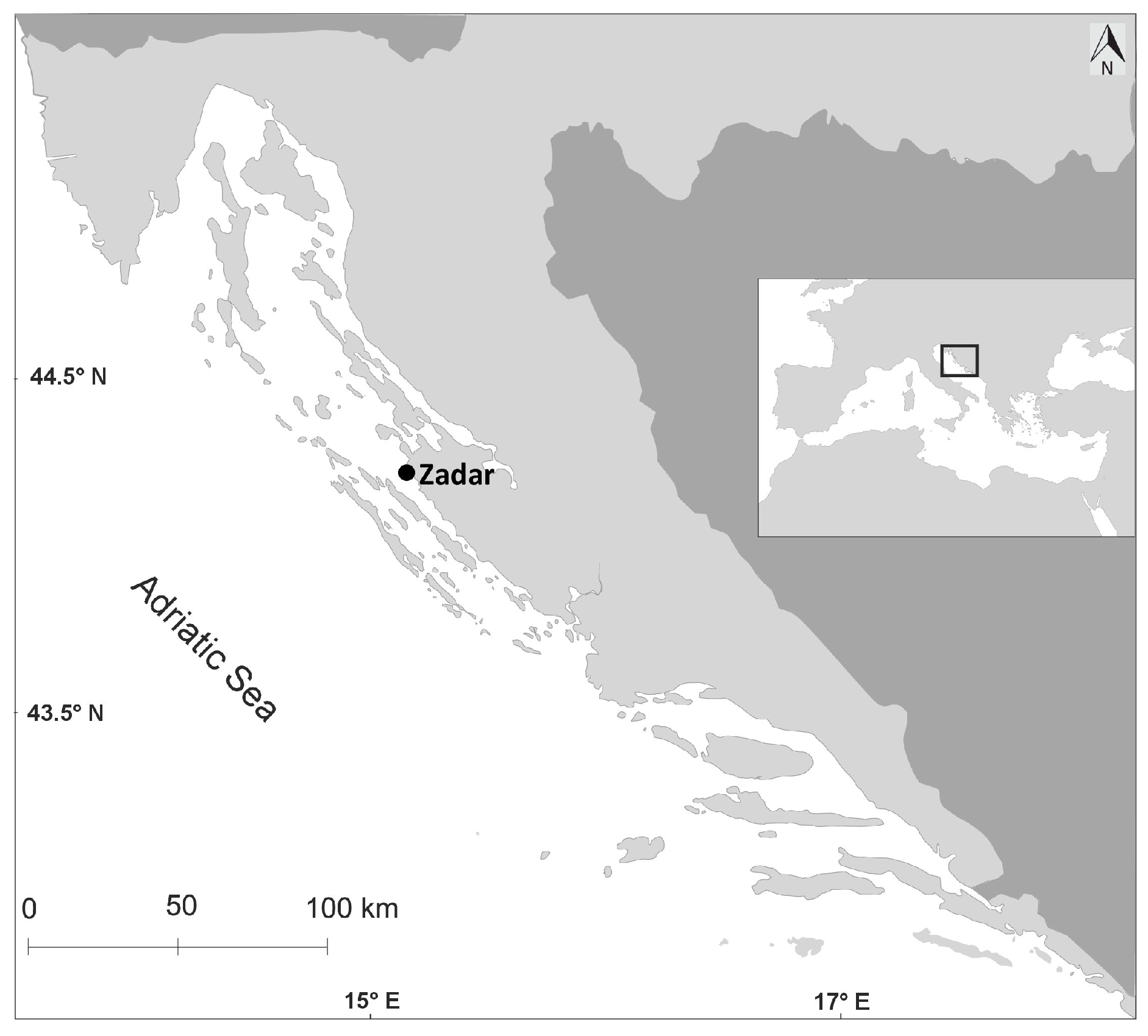
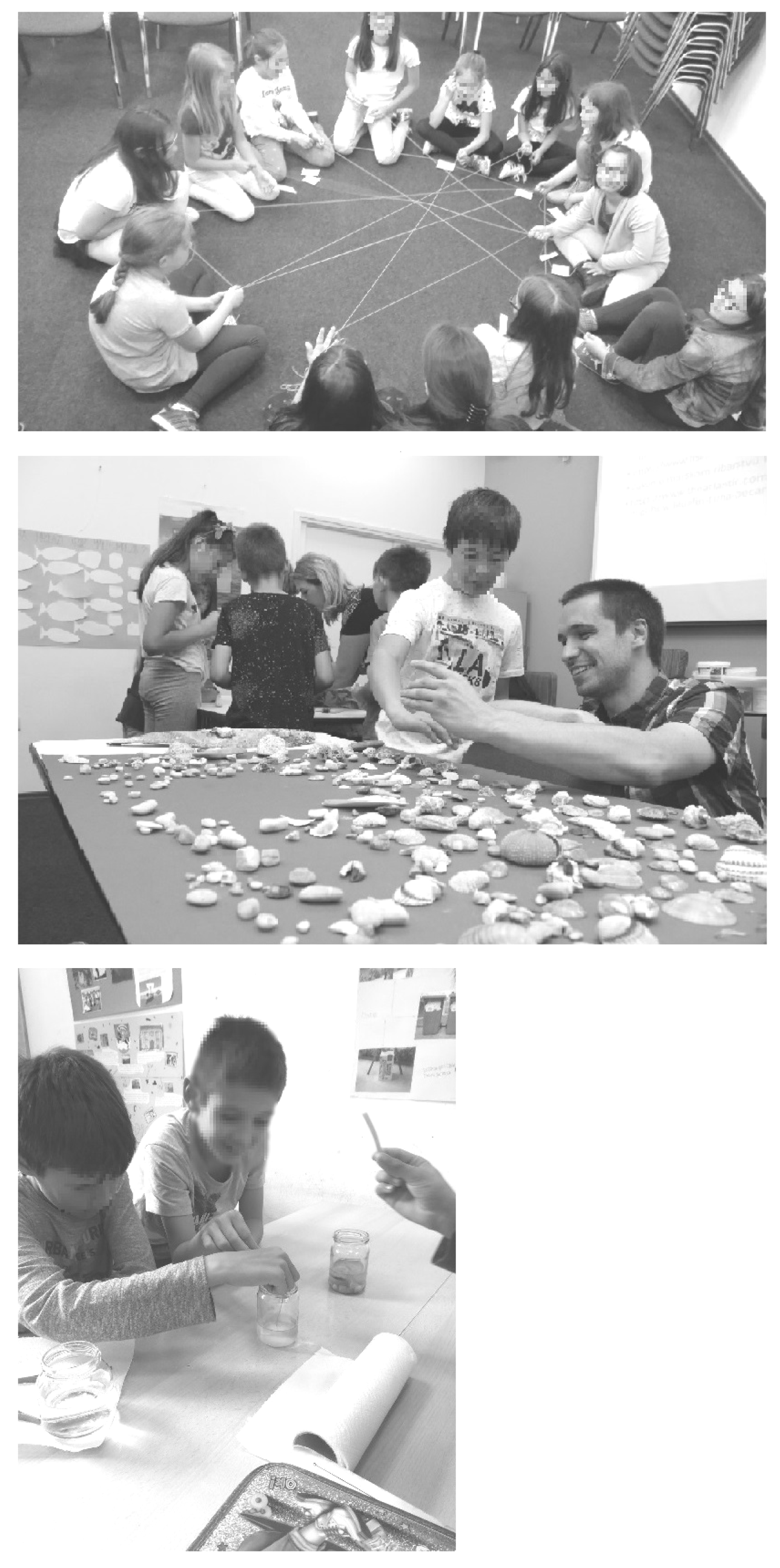

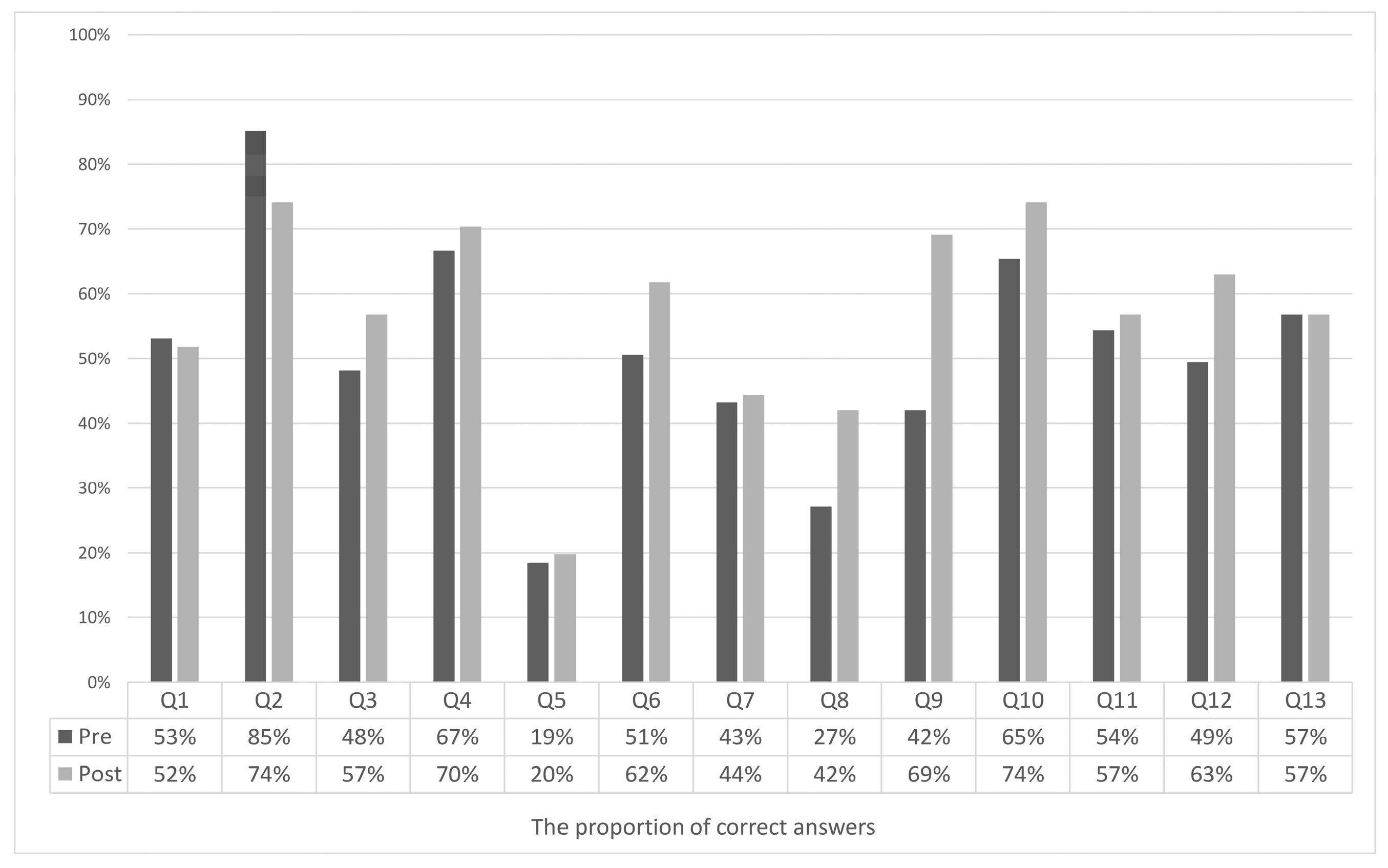
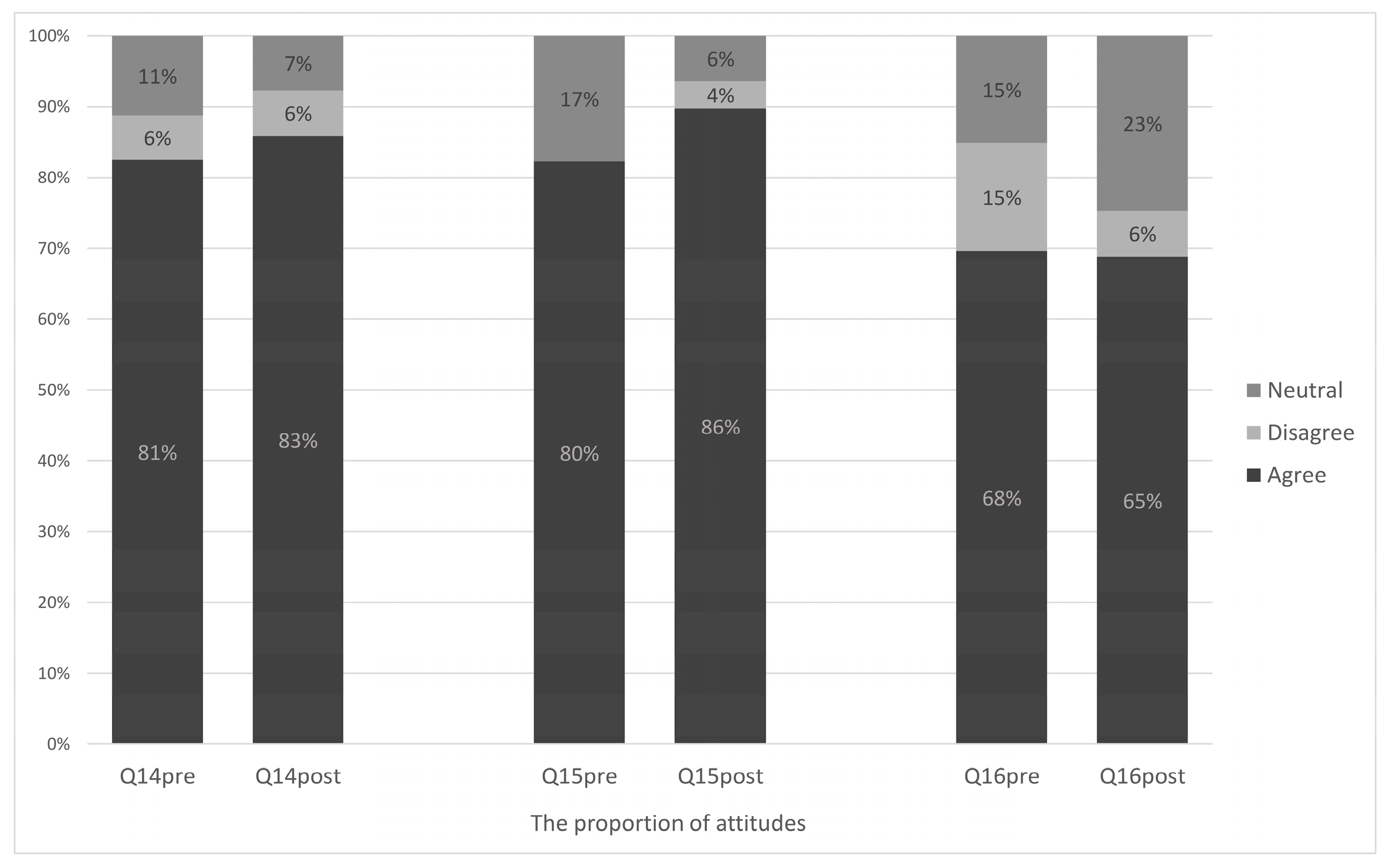
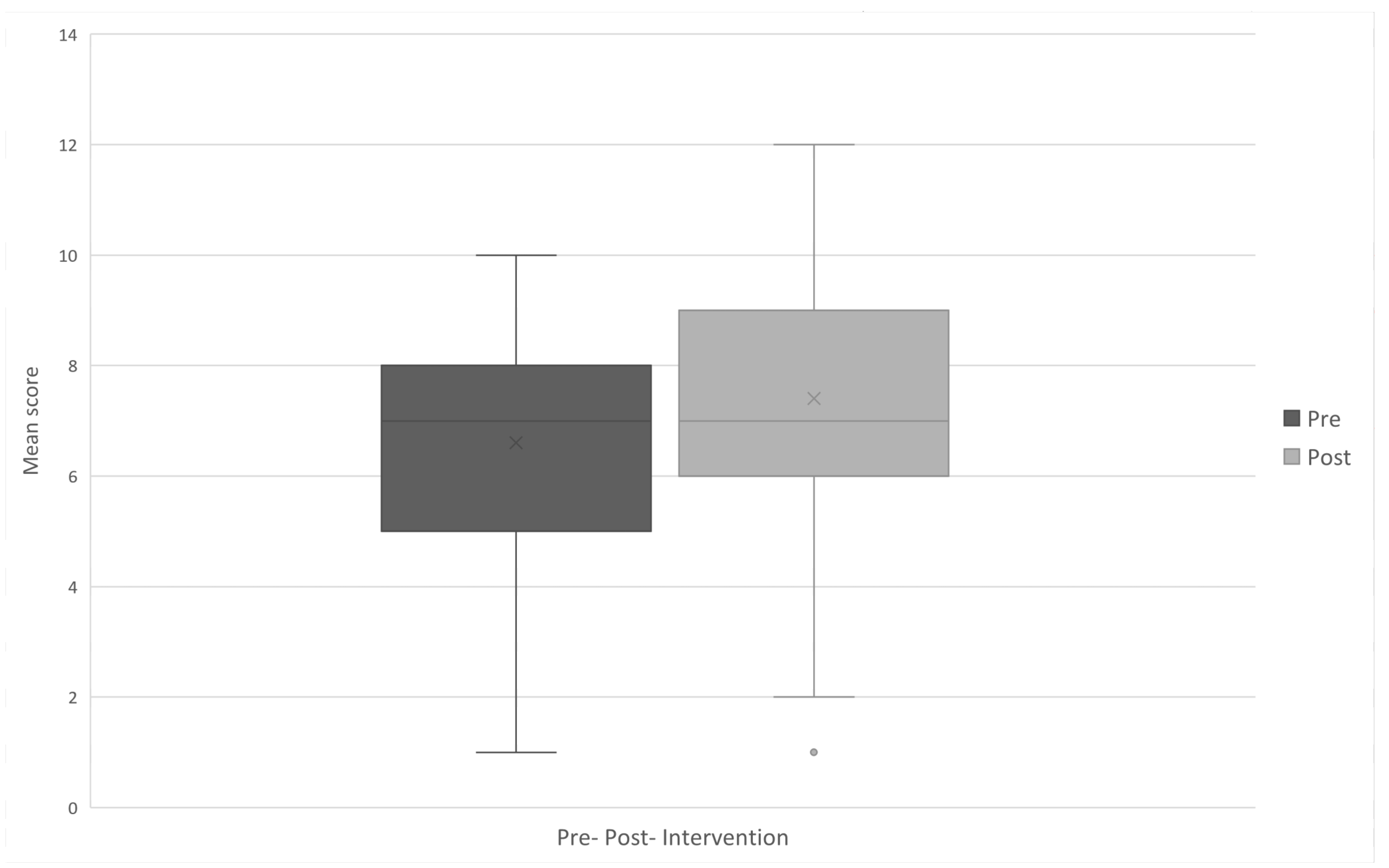
| Ocean Literacy Principle | Questions |
|---|---|
| 1. Earth has one big ocean with many features. | 1,7,13 |
| 2. The ocean and life in the ocean shape the features of Earth. | 2,10 |
| 3. The ocean is a major influence on weather and climate. | 5,11 |
| 4. The ocean makes Earth habitable. | 3,8 |
| 5. The ocean supports a great diversity of life and ecosystems. | 4,9 |
| 6. The ocean and humans are inextricably linked. | 12 |
| 7. The ocean is largely unexplored. | 6 |
Publisher’s Note: MDPI stays neutral with regard to jurisdictional claims in published maps and institutional affiliations. |
© 2020 by the authors. Licensee MDPI, Basel, Switzerland. This article is an open access article distributed under the terms and conditions of the Creative Commons Attribution (CC BY) license (http://creativecommons.org/licenses/by/4.0/).
Share and Cite
Mokos, M.; Realdon, G.; Zubak Čižmek, I. How to Increase Ocean Literacy for Future Ocean Sustainability? The Influence of Non-Formal Marine Science Education. Sustainability 2020, 12, 10647. https://doi.org/10.3390/su122410647
Mokos M, Realdon G, Zubak Čižmek I. How to Increase Ocean Literacy for Future Ocean Sustainability? The Influence of Non-Formal Marine Science Education. Sustainability. 2020; 12(24):10647. https://doi.org/10.3390/su122410647
Chicago/Turabian StyleMokos, Melita, Giulia Realdon, and Ivana Zubak Čižmek. 2020. "How to Increase Ocean Literacy for Future Ocean Sustainability? The Influence of Non-Formal Marine Science Education" Sustainability 12, no. 24: 10647. https://doi.org/10.3390/su122410647
APA StyleMokos, M., Realdon, G., & Zubak Čižmek, I. (2020). How to Increase Ocean Literacy for Future Ocean Sustainability? The Influence of Non-Formal Marine Science Education. Sustainability, 12(24), 10647. https://doi.org/10.3390/su122410647





